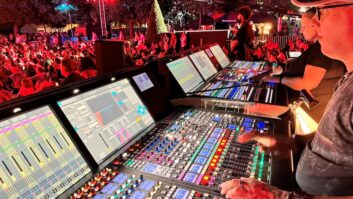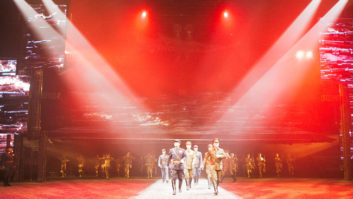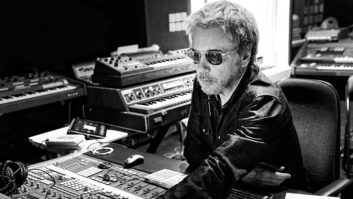Bastille broke through in the US this past year, which led to a headlining tour carrying a sizable L-Acoustics K1 system supplied by Thunder Audio. NEW YORK, NY—It’s been quite a year for Bastille. The UK pop band broke through with the hit “Pompeii” and saw it become the US number-one rock song of 2014, according to Billboard, pushing the group’s debut album, Bad Blood, to platinum status and ultimately helping Bastille land a Grammy nomination for Best New Artist. Seizing the moment, the band did multiple tour legs in North America, quickly building up to a fall tour that carried audio support from Livonia, MI-based Thunder Audio.

Like any “overnight” success, the band’s sudden high profile is actually the result of years of hard work, as longtime FOH engineer, Paul “Coop” Cooper, confirmed with a laugh: “We don’t have breaks; breaks are for other people.”
While the fall tour was the band’s biggest yet in the States, it also marked a major change for Coop in the form of a new console, as he moved to a Midas Pro6 digital live desk outfitted with a RPM Dynamics RPM-TB72R—a stand-alone, 72-channel AES50 I/O unit that allows Midas digital console users to integrate Midas Digital I/O with a Thunderbolt-equipped computer.
“Thanks to this genius little box that Jim Roese invented, I can multitrack 72 channels of every show and also can use all the Waves plug-ins I used on my last desk,” said Coop, recently named a Waves Artist. “Jim sells a 48-channel unit which is his standard box, but I had him make me a 72-channel rack-mount unit. It has three AES50 inputs on the back which allow 72 channels in and out simultaneously, letting me use plugins, compression on channels and stuff off my laptop with minimal latency, not noticeable at all. So I got Waves Mercury bundle and I bought the Abbey Road pack as well, and I needed SoundGrid for using it live. I tend to use H Delay, the IR1 Convolution Reverb, a C4 Compressor on bass, and I’ll put the C6 Multiband Compressor and the H EQ on the main vocal. At the moment, I’m using a Pultec-sort of EQ on the snare, but I’m constantly adding and taking things away from that plug-in chain because I’m still playing with the desk. It’s a nice-sounding show. Obviously with the Midas, I’ve hardly got anything on the drum kit at all—you just push the fader and go ‘Ah, that’s a kick drum!’”
Drums were a key part of the Bastille sound live, as parts of the show found various members of the band bashing custom Premier 20-by-8-inch gong drums at the front of the stage, including singer Dan Smith. Coop recalled, “He used to have a floor tom that he would hit intermittently to emphasize things; when we were playing tiny venues, it was an absolute pain in my [neck], but when we progressed to playing larger places, we miked it. Then the keyboard player wanted one and it became a case of one-upmanship. I came across the gong drum when I mixed a Christmas show for a band called Frost—I put an Electro-Voice RE20 in it, slightly ’verbed it and created this massive, ridiculous drum sound. You could sweep all the top end out of it, barely gate it and get this swelling sub hit. I make the mistake of mentioning it to the band and now we’ve got them. The easiest way to mic it is to put an LP mic claw with a Sennheiser e 902 positioned midway into the shell and that gives me enough options.”
Due to tight patterns, the drum didn’t spill much into the vocal mic—a Sennheiser e 965 capsule on a G3 wireless. The real drum kit itself was surrounded by a variety of e 904s, 902s, 914s, 905s and 901s. Background vocals were on e 935s, the guitar had a e 906 and the bass got an e 905. Meanwhile, Radial DIs could be found on a guitar channel, a Roland SPD-S sampling pad and more, and a Radial SW8 auto-switcher could be found used for redundancy in the keyboards. A pair of redundant JoeCo BlackBoxes were onhand for track playback as well.
Bringing the audio to the audience was Thunder’s newly acquired L-Acoustics K1 system with the tour carrying 24 K1s for mains, 30 Kara enclosures for sidehangs and a dozen SB28 subs. “I love L-Acoustics, always have,” said Coop. “L-Acoustics has always been one of those things I’ve gone to by default—the top of my spec—because from the V-Dosc and dV-Dosc and even back to Arcs, you knew what you were going to get and it was going to work. The K1s are like that, too, and Thunder’s techs are amazing with them; I’m walking into the same gig here every day, no matter the venue. I’ve worked very close with Johnny [Winkler, systems engineer] and the owners of the company are wonderful; they’re a great bunch of guys.”
Since first being asked to tour with the band, Coop has seen Bastille rise from small London clubs to U.S. arenas and international festivals, case in point being a pair of massive New Zealand summer fests that the band played to ring in 2015. “I’ve been with them for three years and become really good friends with them. When we first went on tour, I was the most toured person—and it went from going out with a couple of cars to now, where we’re three busses and three trucks. Just seeing how they’ve grown and how they progress with every show, it’s fantastic—really nice to see.”
Thunder Audio
Thunderaudioinc.com
L-Acoustics
l-acoustics.com




